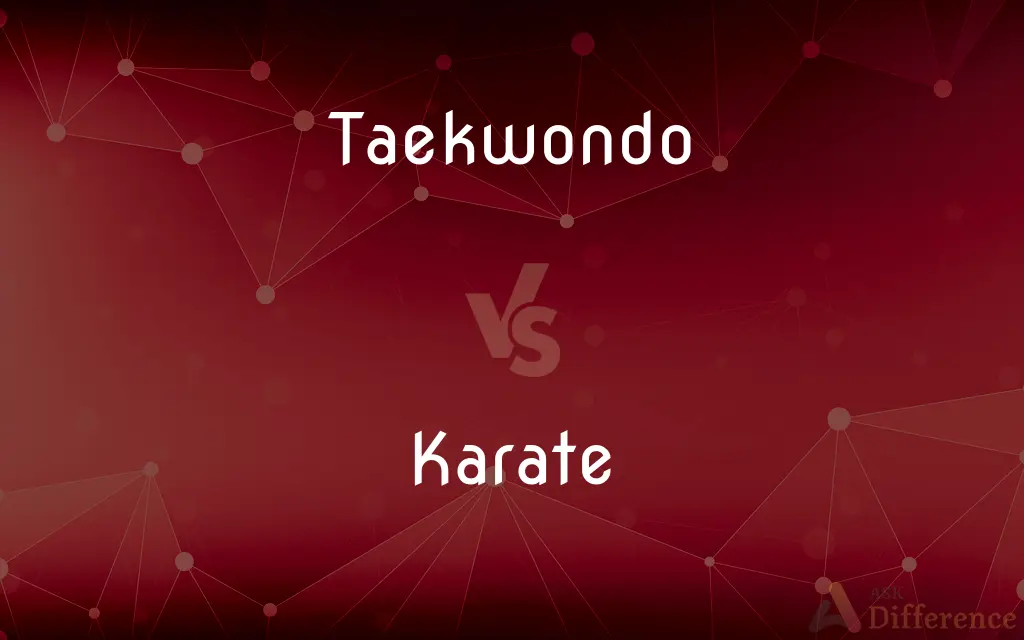Taekwondo vs. Karate — What's the Difference?
Edited by Tayyaba Rehman — By Fiza Rafique — Updated on October 13, 2023
Taekwondo is a Korean martial art emphasizing high kicks and jumping/spinning kicks. Karate is a Japanese martial art focusing on striking with hands, feet, elbows, and knee techniques.

Difference Between Taekwondo and Karate
Table of Contents
ADVERTISEMENT
Key Differences
Taekwondo and Karate, although both are martial arts, originate from different countries, with Taekwondo hailing from Korea and Karate originating in Japan. Taekwondo is recognized for its impressive, acrobatic kicking techniques, demonstrating a range of high, spinning, and jumping kicks. Karate, on the other hand, is globally acknowledged for its diverse range of striking techniques, utilizing not just kicks, but also punches, knee strikes, and elbow strikes.
The philosophical underpinnings of Taekwondo and Karate also provide insightful differences, where Taekwondo often embodies the spirit of "the way of foot and fist" and primarily aims at self-discipline and the development of a strong spirit. In contrast, Karate often adheres to the concept of "empty hand", indicating a focus on achieving power and precision in strikes without the necessity of a weapon, and aligning the mind, body, and spirit.
The stances in Taekwondo and Karate are notably different as well. Taekwondo stances are generally narrower and more upright, aligning with the dynamic, mobile nature of its techniques. In contrast, Karate stances tend to be wider and more grounded, providing a stable base from which to deliver strong, powerful strikes, revealing a clear distinction in strategic posture between the two martial arts.
Uniforms, while seemingly a minor detail, also present a striking contrast between Taekwondo and Karate. Taekwondo practitioners often wear a v-neck style uniform, whereas Karate practitioners commonly wear a crossover style uniform. This distinction in attire, while subtle, underscores the unique cultural and stylistic nuances that each martial art observes.
Additionally, competition and scoring systems in Taekwondo and Karate vary significantly. Taekwondo competitions typically score points through controlled, accurate kicks to the head and torso, valuing technique and control, with a notable allowance for more acrobatic and high-reaching kicks. Karate competitions emphasize precise, powerful strikes, rewarding competitors for demonstrating control, power, and effective self-defense techniques within their performance.
ADVERTISEMENT
Comparison Chart
Origin
Korea
Japan
Emphasized Techniques
High, jumping and spinning kicks
Hand and foot strikes, with various punches
Philosophical Basis
The way of foot and fist
Empty hand
Stances
Narrower and more upright
Wider and more grounded
Uniform Style
V-neck style
Crossover style
Compare with Definitions
Taekwondo
An Olympic sport since 2000.
Taekwondo has been spotlighted globally during the Olympics.
Karate
A Japanese martial art focusing on striking.
He teaches Karate to children and adults alike.
Taekwondo
A Korean martial art emphasizing kicks.
She has a black belt in Taekwondo.
Karate
A method of self-defense using no weapons.
Karate emphasizes defending oneself with empty hands.
Taekwondo
A practice blending combat and self-defense.
Taekwondo training enhances physical fitness and defensive skills.
Karate
A martial art involving kata, or structured forms.
He practices Karate kata daily to enhance his skills.
Taekwondo
A martial art with notable, aesthetic forms.
She performs Taekwondo forms with grace and power.
Karate
A martial art emphasizing controlled, powerful strikes.
Her Karate strikes are both accurate and impactful.
Taekwondo
A discipline fostering strength and spirit.
Through Taekwondo, he developed physical and mental strength.
Karate
A practice promoting physical and mental discipline.
Karate trains the body, mind, and spirit concurrently.
Taekwondo
Taekwondo, Tae Kwon Do or Taekwon-Do (; Korean: 태권도/跆拳道 [tʰɛ.k͈wʌn.do] (listen)) is a Korean martial art, characterized by punching and kicking techniques, with emphasis on head-height kicks, jumping spinning kicks, and fast kicking techniques. The literal translation for tae kwon do is "kicking," "punching," and "the art or way of." It is a martial art that attacks or defends with hands and feet anytime, anywhere without any weapons, and the purpose of physical training is important, but it also has great significance in fostering the right mind through mental armament.Taekwondo practitioners wear a uniform, known as a dobok.
Karate
Karate (空手) (; Japanese pronunciation: [kaɾate] (listen); Okinawan pronunciation: [kaɽati]) is a martial art developed in the Ryukyu Kingdom. It developed from the indigenous Ryukyuan martial arts (called te (手), "hand"; tii in Okinawan) under the influence of Kung Fu, particularly Fujian White Crane.
Taekwondo
A martial arts form from Korea, known for its elaborate kicking techniques. The sparring aspect is a recognised Olympic sport.
Karate
A Japanese martial art in which sharp blows and kicks are administered to pressure-sensitive points on the body of an opponent.
Karate
An Okinawan martial art involving primarily punching and kicking, but additionally, advanced throws, arm bars, grappling and all means of fighting.
Karate
To attack (somebody or something) with karate or similar techniques.
Karate
A traditional Japanese system of unarmed combat; sharp blows and kicks are given to pressure-sensitive points on the body of the opponent.
Karate
A traditional Japanese system of unarmed combat; sharp blows and kicks are given to pressure-sensitive points on the body of the opponent
Common Curiosities
Where do Taekwondo and Karate originate?
Taekwondo originates from Korea, while Karate originates from Japan.
Are Taekwondo and Karate Olympic sports?
Taekwondo has been an Olympic sport since 2000, while Karate was introduced in 2020.
What are the uniforms like in Taekwondo and Karate?
Taekwondo uses a v-neck uniform, while Karate uses a crossover style uniform.
What physical benefits do Taekwondo and Karate offer?
Taekwondo and Karate enhance strength, flexibility, and cardiovascular health.
Are there belt systems in Taekwondo and Karate?
Yes, both Taekwondo and Karate utilize a belt system to denote rank and skill level.
How does one progress in ranks in Taekwondo and Karate?
Progression in Taekwondo and Karate typically involves testing for higher belt ranks through demonstrated skills.
How do the philosophies of Taekwondo and Karate differ?
Taekwondo seeks to unify foot and fist, while Karate embodies the principle of the "empty hand."
Are forms or katas a part of Taekwondo and Karate training?
Yes, both martial arts involve the practice of forms (poomsae/kata) as a key training element.
What is the primary striking focus in Taekwondo versus Karate?
Taekwondo emphasizes kicks, whereas Karate involves various hand and foot strikes.
Are there any self-defense applications in Taekwondo and Karate?
Absolutely, both Taekwondo and Karate encompass valuable self-defense techniques and principles.
Are Taekwondo and Karate suitable for all ages?
Yes, both Taekwondo and Karate can be practiced by individuals of various ages.
Are competitions available for Taekwondo and Karate practitioners?
Yes, there are numerous local, national, and international Taekwondo and Karate competitions.
Is breaking objects (like boards) part of Taekwondo and Karate?
Yes, breaking is practiced in both Taekwondo and Karate as a demonstration of power and technique.
Can Taekwondo and Karate be utilized for improving mental health?
Yes, the disciplined practice of Taekwondo and Karate can enhance mental focus and reduce stress.
Are there worldwide organizations for Taekwondo and Karate?
Yes, World Taekwondo (WT) and the World Karate Federation (WKF) are notable organizations for Taekwondo and Karate respectively.
Share Your Discovery

Previous Comparison
Realism vs. Naturalism
Next Comparison
Cardigan vs. JacketAuthor Spotlight
Written by
Fiza RafiqueFiza Rafique is a skilled content writer at AskDifference.com, where she meticulously refines and enhances written pieces. Drawing from her vast editorial expertise, Fiza ensures clarity, accuracy, and precision in every article. Passionate about language, she continually seeks to elevate the quality of content for readers worldwide.
Edited by
Tayyaba RehmanTayyaba Rehman is a distinguished writer, currently serving as a primary contributor to askdifference.com. As a researcher in semantics and etymology, Tayyaba's passion for the complexity of languages and their distinctions has found a perfect home on the platform. Tayyaba delves into the intricacies of language, distinguishing between commonly confused words and phrases, thereby providing clarity for readers worldwide.















































